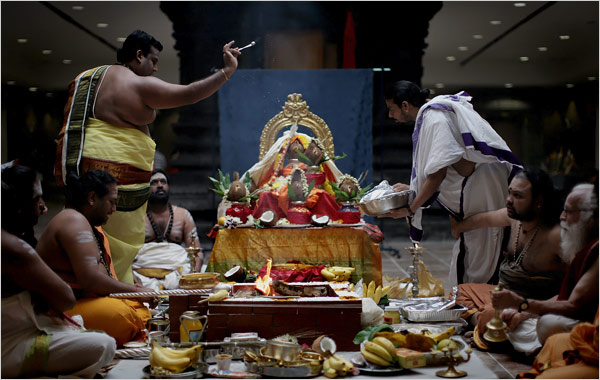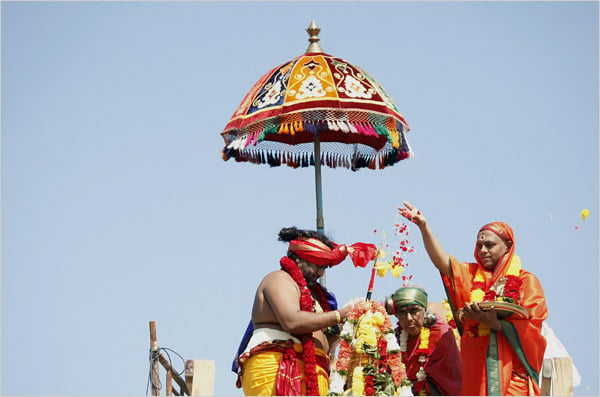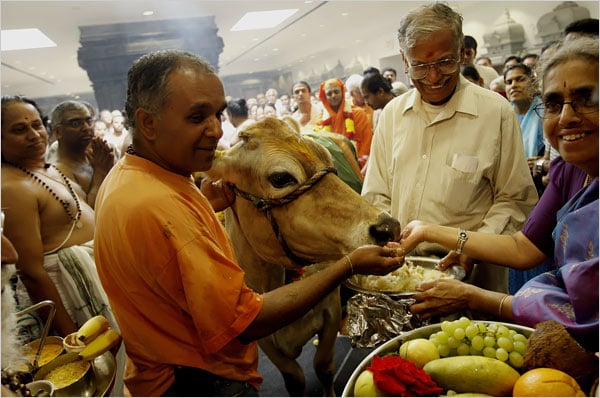Ashadh Krushna Dashami, 5111
An expectant crowd had gathered, dressed in tropically colored saris and dhotis — mango, teal, violet and saffron — that stood out against the beige and pale green houses of a quiet street in Flushing, Queens.
“Make way!” someone shouted, and the crowd parted to reveal Minnie, a 37-year-old Indian elephant.
Minnie wore a gold-studded shield on her forehead and carried a bare-chested Hindu priest with a silver-tasseled parasol. Untroubled by the din of cheers, chants and bells, she emerged just before 8 a.m. from the driveway on Bowne Street, stepped carefully off the curb and sashayed across the street into a Hindu temple. In keeping with the Hindu belief that there is divinity in every living thing, she was greeted with melons and incense as a manifestation of Ganesha, the elephant-faced deity revered for removing all problems and obstacles.
The elephant’s visit began the fifth day of rituals to reconsecrate the temple’s stone deities, a ceremony important enough to draw thousands of Hindus from the New York region and as far away as the Midwest.
The ritual at the Hindu Temple Society of North America’s Ganesh Temple, one of the nation’s oldest and largest temples founded by Hindu immigrants, was a twist on a consecration ceremony, which the faithful believe infuses divine energy into stone statues of the Hindu gods.
 Hindu Priests performing ritual for Reconsecration |
As part of a $4 million renovation begun in 2007, another ritual removed the divine energy from the icons and placed it in smaller pictures of the gods, so the statues could be stored.
 Preists performing ritual on newly built towers of Lord Ganesh Temple |
The ornate ceremony may not have been what the neighborhood’s colonists had in mind in 1657 when they signed the Flushing Remonstrance, a document often credited as a precursor to the Bill of Rights’ declaration of freedom of religion. The signers, protesting the Dutch colonial authorities’ persecution of Quakers, did not mention Hindus, but they noted that the same liberties apply to “Jews, Turks and Egyptians.”
Soon afterward, a farmer named John Bowne allowed Quakers to meet at his house. It still stands nearby on the street named after him, which is now home to two Hindu temples, a Chinese church, a synagogue and a Sikh gurdwara.
 Devout Hindus present for Reconsecration of Lord Ganesh Temple |
The ceremony, and the growth of the temple community that it illustrates, reflect the spirit of the Flushing Remonstrance and its emphasis on “hospitality to strangers,” said Diana L. Eck, a professor of comparative religion and Indian studies at Harvard University, who has often visited Bowne Street.
“This has long been the case in American religion, that one of the indices of your arrival in this country is to put forth a major place of worship,” she said.
Her Pluralism Project has documented 722 Hindu temples in the country, including dozens of “permanently consecrated” houses of worship like the one in Flushing, with a priestly staff to attend the holy statues. The number of United States residents born in India, where Hinduism is the predominant religion, has increased more than thirtyfold since 1970, to 1.5 million; in New York it has risen twelvefold, to about 78,000, census data show.
The influx has made consecration ceremonies more common across the country, religious scholars say, as Hindu communities that have taken root since immigration restrictions were eased in 1965 become prosperous enough to inaugurate major temples — often with priests and sacred plants flown from India and flowers dropped from helicopters in a kind of coming-out party.
“This is a once-in-a-lifetime experience for me,” Anuradha Nath, who retired recently as a librarian from the Queens Library, said as Minnie raised her trunk in the air, showing off her pink and gray speckled tongue. Mrs. Nath immigrated from India 42 years ago, and has been a member of the temple through all its phases: attending ceremonies in people’s homes in 1969, buying a Russian Orthodox church building in 1972, consecrating it on the Fourth of July in 1977, and now seeing it through the expansion, which included flying in thousands of tons of Indian granite.
The temple’s president, Dr. Uma Mysorekar, a gynecologist, recalled that the building was pelted with eggs when it first opened, because people equated Hinduism with a cult. More than two decades later, Dr. Mysorekar was one of the Hindu leaders invited to attend the National Cathedral ceremony for President Obama’s inauguration.
Like many founders of American temples, she believed that the children of immigrants would need a temple as a focus for religious and cultural identity. Indeed, the temple was packed with young people, like Shruthi Rajan, 22, who grew up traveling to the temple from Dix Hills, in Suffolk County, and skipped college classes to attend on Monday.
To carry out the ritual, called maha kumbhabhishekam, Dr. Mysorekar struggled to get visas for specialized priests and a temple designer from India. Then there was the importing of certain seeds, twigs and plants that made customs authorities suspicious, she said.
 Sacred Cow being feeded by Devout Hindus in ceremony |
On Thursday, she brought in a cow, particularly sacred to Hindus, who was petted and fed unpeeled bananas until it rebelled and had to be led outside. On Monday, after Minnie’s arrival from a petting zoo in Litchfield, Conn., priests lighted fires and threw in milk, honey and spices to infuse the holy water with divinity. They then carried the water in metal containers, called kumbhas, on their heads, draped with garlands of flowers, to a hydraulic lift normally used by the construction crew.
The priests, dressed in red and orange dhotis, rose slowly to the roof as if floating. They climbed barefoot onto scaffolding around the stone towers and poured the water on the towers, and then on the deities. People rushed to catch drops.
The construction continues. Michael and Thomas Graysing, contractors in Babylon, on Long Island, describe themselves as “Roman Catholic boys” who have learned — now that temple building has become one of their specialties — to rattle off Hindu terms in their New York accents, and to harbor a deep respect for the places of worship.
“We build high-end houses, but the structure is, like, dead compared to this,” Michael Graysing said.
Source: The New York Times
Also See
 |
Dharma Jagruti SabhasDhama Jagruti Sabhas is creating mass awareness among Hindus about various problems affecting Hindu Dharma. |
 |
Save temples from Anti-HindusTemples are the centres of Hindu Dharma. Anti Hindu forces like Muslims, Congress, Christians has constantly targetted them. HJS is fighting against these forces. |




